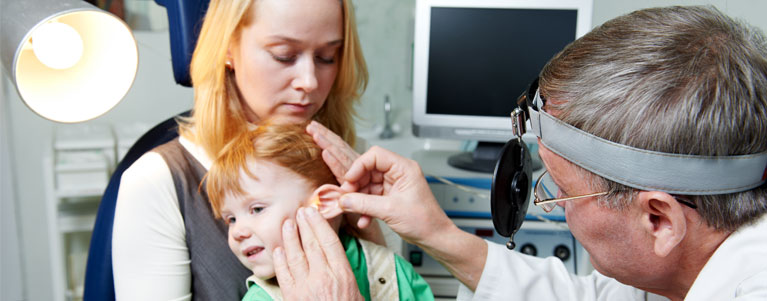HEARING DEVELOPMENT IN CHILDREN
What are the developmental milestones of hearing?
A typical baby will pass through a series of developmental milestones that let both parents and doctors know that the baby can hear – see the page on hearing development in infants.
The cooing and babbling that a baby produces also serves a developmental purpose. An infant who “coos” with vowel-like sounds is playing and practicing with the sounds of speech. At about six months of age, a baby will start to add more consonants to the verbal activity so that the cooing changes character and becomes “babbling.”
How can hearing loss affect speech/language development?
Even partial hearing loss can interfere with speech/language development. If the baby cannot hear, then the pleasing auditory feedback that cooing produces will not reinforce the development of babbling. The later a hearing loss is discovered, the more difficult it is to teach oral speech/language to the child. Therefore, it is very important that hearing loss be discovered as early as possible.
How can ear infections affect speech/language development?
Speech/language development may also be delayed if a child has repeated ear infections. Ear infections are usually accompanied by fluid in the middle ear that reduces the vibration of the tiny bones of the middle ear. This produces a mild but sometimes moderate, temporary hearing loss, with a usual return to normal hearing when the fluid is eliminated from the middle ear.
Even though the ear may not be infected, fluid may still be retained in the middle ear. The presence of the mild hearing loss, and the fact that hearing fluctuates with repeated ear infections, interferes with a solid base for speech/language development. The situation is similar to a child learning to walk on a moving surface. The delay of speech/language development often improves to an age-appropriate level once the fluid is finally removed from the middle ears. But occasionally, speech/language therapy may be necessary.
When can children’s hearing be tested?
A baby is never too young to have a hearing test. The age of the child determines the specific test that is used. Before seven months of age, Otoacoustic Emissions (OAEs) or the Brainstem Auditory Evoked Response (BAER) is used. OAEs are measured by a small probe that is inserted in the baby’s ear canal (see OAEs). The BAER involves placing electrodes on the baby’s head. The change in electrical activity (EEG) of the brain in response to sound is computer processed while the child is asleep. This diagnostic test is non-invasive and causes no discomfort.
Children older than nine months of age can be tested by a method called “Visual Response Audiometry” or VRA. The child is placed in front of speakers while sitting on a parent’s lap. Speech and other sounds are presented through speakers, while the audiologist looks for a head turn, cessation of activity, or other signs that the child has heard the sound. A toy above the speaker is activated to reward the child for paying attention to the sound. The loudness of the sound is then decreased to the minimal level that still results in an alerting or searching response.
“Play Audiometry” is used with older children who can be taught to point to body parts, put a block in a can when a tone is heard, repeat very soft words, or raise a hand like an adult when a tone is presented.
A final thought…
Please remember that a child at any age can be tested, even newborns. Infants with a hearing loss miss many important milestones and learning experiences. Babies can’t tell us they don’t hear.
Parents should be alert to any sign of hearing loss and can refer to the Hearing Milestones (Hearing Development in Infants) to monitor the child’s development. If you suspect that your baby is not hearing normally, talk to your baby’s doctor and request that your baby receive a thorough hearing test. It is never too early to test your baby’s hearing.

